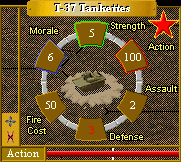
Game Statistics

|
| Victory Points |
Armour | Start | Start | End | End | ||
| Front | Side | Rear | Month | Year | Month | Year | |
| 2 | 3 | 1 | 1 | 11 | 39 | 12 | 41 |
| T-37 Tankette | ||||||||||||||||||||
| RANGE | 1 | 2 | 3 | 4 | 5 | 6 | 7 | 8 | 9 | 10 | 11 | 12 | 13 | 14 | 15 | 16 | 17 | 18 | 19 | 20 |
| HARD | 2 | . | . | . | . | . | . | . | . | . | . | . | . | . | . | . | . | . | . | . |
| SOFT | 3 | 1 | . | . | . | . | . | . | . | . | . | . | . | . | . | . | . | . | . | . |
History
|
|
|
Specification |
|
During 1931, the eight amphibious Carden-Loyd tankettes which had been purchased in England under the 1931 negotiations were used as the basis for a new light amphibious tank. A prototype was completed at AMO in 1932 and was designated "Morskoi 33". This first prototype of the T-33 weighed 3 tons and had a two-man crew. Armed with a single 7.62mm DT MG in a 360 degree traverse turret, its armour varied from 7-9 mm. A petrol engine provided 63hp and gave the vehicle a maximum speed of 28mph. A second prototype of the T-33 was fitted with an improved suspension and a new armour arrangement. The new suspension was a modified Horstmann scissors type which replaced the original Carden-Loyd suspension which was found to be unsuitable for Russian terrain. The second prototype was completed in 1933, and was designated T-37 plavaiushchiya (amphibious) tank. The hull configurations was almost identical to that on the original Carden-Loyd tankette. New changes was the turret fitted to the left, and the modified tracks and propeller drive systems. The exterior of the vehicle was strengthened against wave buffeting. The early production models, believed to have been designated 3-2T, had small welded turrets with flush tops, similar to those fitted on the T-26A. During the Finnish Winter War these were replaced by a larger and roomier turret with a raised hatch cupola. The vehicle had a single propeller and rudder fitted on the rear hull, with a power takeoff from the engine for the propeller. Encased in sheet metal, balsa-wood floats were fitted in form of trackguards to provide additional buoyancy to the watertight hull. The engine was cooled by air from a large fan housed in a riveted box, built on the rear deck of the tank. With the driver seated to the left of the turret, the engine was placed to the right in the rear. The sprockets and final drives were at the front, drive being transmitted from the engine at the rear, via carden shafts passing under the crew compartment to the gearbox at the front of the vehicle. Through a differential to the final drives, direct drive was taken from the gearbox. The gear-changing and steering methods were identical to those adopted on the T-27 tankette. No radio was fitted in the T-37, except for the command version, T-37U, which adapted a large frame aerial around the hull. The Russians had a hard time to form a watertight seal on this tank, due to its riveted construction, and production ceased after only 70 vehicles had been built. A modified version, designated T-37A, was built during 1935 with thicker die-formed armour plates welded and riveted, making the tank a bit heavier. The T-37A had abandoned the balsa floats on the trackguard. Another project was undertaken with the SU-37, armed with a 45mm Model 1932 L/46 gun. When production finally ceased in 1936, a total of 250 T-37s and T-37A had been built by AMO in Moscow. Both models were issued to reconnaissance units of the infantry, cavalry and mechanized formations during the 1939-41 campaigns against the Finns and the Germans. |